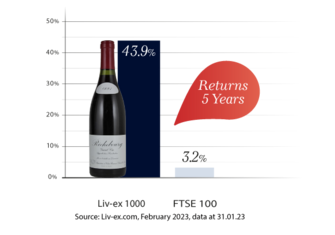The slow-down in fine wine price growth over recent months has seen the brakes applied on the vinous bull run investors have enjoyed since May 2020.
Softening prices could offer investors the opportunity to average down on certain positions over the coming months should the trend continue. Despite a drift in prices, the fine wine market is maintaining strong activity with the total value of live offers on Liv-ex in January 2023 hitting a record £70million. 17,000 distinct wines reflected the continued broadening of the secondary market, providing investors with more choice in terms of price point, brand, region and vintage.
Emerging wine investment trends in 2023
Investors have also been distracted by a resurgence in equity markets as some confidence returned in response to promising inflation data in key economies. The FTSE 100 rose 1.8% and the S&P500 was up 5.6% in January, whilst the Liv-ex 1000 dipped -0.8% and the Liv-ex Burgundy 150 recorded just 0.4% growth. Over one year fine wine has maintained stability and growth whilst equities have been volatile and seen periods of very significant loss.
Asset comparison over different periods
Asset | Benchmark | 1 year | 5 years | 10 years |
Fine wine | Liv-ex 1000 | 8.4% | 43.9% | 88.9% |
Burgundy | Liv-ex Burg. 150 | 19.6% | 105.6% | 226.8% |
UK equities | FTSE 100 | 5% | 3.2% | 22.9% |
US equities | S&P500 | -8.5% | 44.4% | 172.1% |
Source: Liv-ex.com, 21.02.2023, data at 31.01.23
It’s important to remember that equities are more volatile than tangible asset fine wine and you will see more movement, both up and down in value, over shorter periods of time in shares than stable fine wine. Fine wine should be considered as a medium to long term hold to enjoy the best possible returns.
Regional wine investment drivers
Champagne and Burgundy were the top performing regions for investment wines during 2021 and 2022. Both have seen their share of trade in the secondary market expand and prices increase in recent years. The average prices of investment wines from the regions were recorded by Liv-ex’s regional benchmarks. The Liv-ex Burgundy 150 rose 26.7% in 2022 and the Champagne 50 index increased 18.7% and over five years they grew by 102.4% and 99.6% respectively to the end of December 2022.
Burgundy investments in Q1 2023
These key markets saw a slowdown in growth in Q4, 2022. In January Burgundy held its position as the leading region for investment wines with individual top performers recording around 13% price growth in the month, but general trend was a more modest 0.4% uplift. The Burgundy 2021 vintage en primeurs release kept buyer focus trained on the region’s Grand Crus and trade share increased from 22.8% in December 2022 to 26.5% in January on the secondary market.
Champagne wine investment in Q1 2023
In contrast Champagne has had a more challenging start to 2023, with a dip in average prices. The Liv-ex Champagne 50 slipped -4.3% in the month, but is still up 59% over two years and 88.5% over five to the end of January 2023.
Trade remained high in key investment Champagne; the region was the only one to increase its market share on Liv-ex in January. Louis Roederer Cristal 2014 led by value traded, although prices were lower than the peak set in October 2022. Buyers are taking advantage of price drift right now.
Our view on wine investment in Q1 2023
Fine wine investments have enjoyed a significant bull run since the pandemic grabbed hold of the world in Spring 2020, so perhaps it’s time for some form of consolidation and in Champagne in particular. Ultimately, supply is finite and reducing as wines are consumed so over the long term it is still delivers stronger returns than equities, gold and other assets such as UK property.
Equities have been enjoying a robust rally since the start of Q4 2022 but the conditions shaping the market are still a long way from predictable.
“A tale of shrinking economic activity is still unfolding in countries around the world, adding fresh nervousness to investor sentiment which is already wavering over worries about the path of interest rates. … There is an argument that equities have already priced in an interest rate pivot to lower and eventually no rate hikes. … Central banks won’t reduce interest rates until economies show signs of pain. And that’s bad for stocks.” Susannah Streeter, Head of Money Markets at Hargreaves Lansdowne, 21st February 2023.
With this view in mind, we can expect further volatility in financial markets and the need for safe havens that deliver stability. Fine wine has more than demonstrated its ability to preserve wealth and has cemented its value as a diversification asset.
A further factor in Q1 2023 is tax. Profits made on wine investment are generally exempt from Capital Gains Tax, this is a significant benefit as the Capital Gains Allowance is due to be halved in April.
The softening in prices in Q1 2023 could offer a timely opportunity for wine investors. As with all investments prices can go down as well as up. For more information on the current market conditions see our February Market Update and speak to a member of our expert team on 0203 384 2261.

